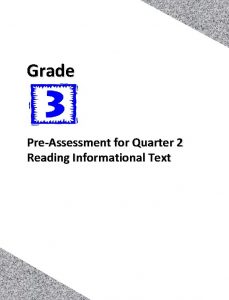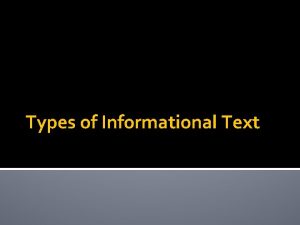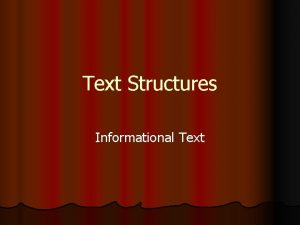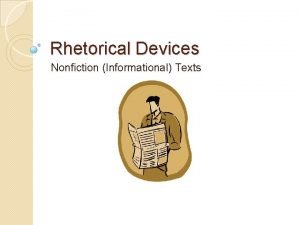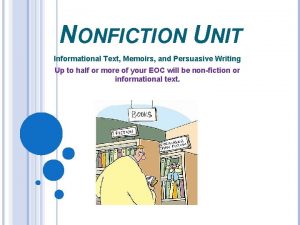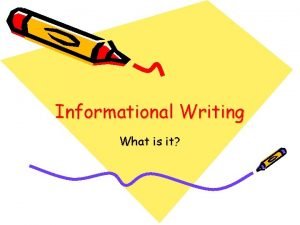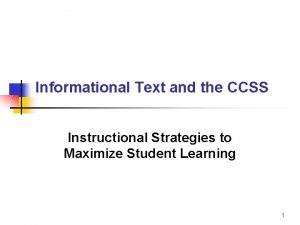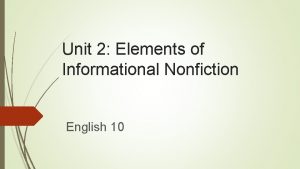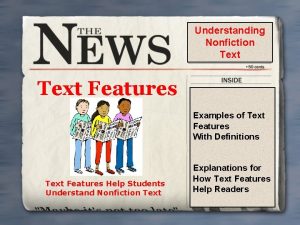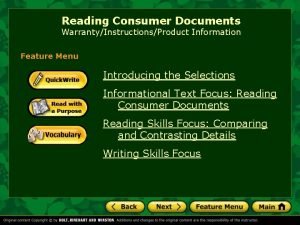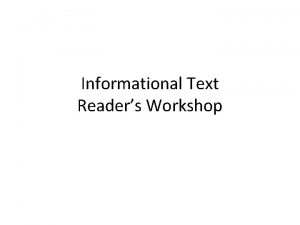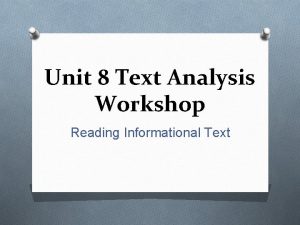Unit 8 Text Analysis Workshop Reading Informational Text











- Slides: 11

Unit 8 Text Analysis Workshop Reading Informational Text

Part 1: Text Features 1. Text features can help readers find and evaluate information quickly. 2. Examples of text features include: O A title that reveals the topic of the article O Subheadings that highlight what each section of the article is about. O A sidebar that provides more information. O A bulleted list that presents information in an easyto-read fashion.


Part 1: Text Features B. Use the chart to help you remember how text features in an article can organize info Features Examples Gives information about Subheadings Hot Dogs in Europe • European origin of hot dogs • What the paragraph or section will discuss Sidebar Hot Dog Specialties • Regional differences in hot dogs • Describes info not given in the article itself Bulleted List Regional Varieties of Hot Dogs • Regional varieties of hot dogs are described • Details described in an easy-to-read format

Part 2: Main Idea and Supporting Details 1. The topic of a work of nonfiction is what the text is about. It is usually expressed in couple of words. 2. The main idea is the most important statement about a topic that the writer wants to convey. 3. The topic sentence is a statement of the main idea of a paragraph or section of a text.

Part 2: Main Idea and Supporting Details 4. Supporting details include facts, examples, sensory details, incidents, and stats 5. The function of supporting details is to back up or support the main idea. 6. A main idea might be stated directly or implied.

Part 2: Main Idea and Supporting Details 7. Taking notes can help readers remember main ideas. 8. Ways to take notes include formal outlines, bulleted lists, graphic organizers 9. When readers take notes, they should determine what info is most important and then restate it on their own.

Use the boxes below to record visual representations of 3 types of note-taking I. Topic 1 A. Supporting idea 1 B. Supporting idea 2

“Over the Top” Text Analysis: Graphic Aids O Magazine articles like the one we are reading today often contain graphic aids. O Graphic aids are visual representations of information. They include… O Photographs/pictures, maps, diagrams, graphs, and timelines O Writers use these to highlight or summarize important concepts and to explain things in fewer words.

Text Analysis: Graphic Aids O As you read, use a chart like the one shown below to takes notes on the articles graphic aids. Graphic Aid What it Explains Notes…

Reading Strategy: Adjust Reading Rate to Purpose O Effective readers change the speed at which they read to suit their purpose. Try this as you read the article. When your purpose is to… Adjust your rate like this… Get an overview of the article Skim before you begin. This involves quickly reading the title subheadings, and any graphic aids Find key words or particular information Scan the text. This involves moving your eyes quickly over the text, looking for the info or words you need. Gain a full understanding or clarify something Read the material at a slower pace, and reread if needed.
 Chapter 2 reading informational text answer key
Chapter 2 reading informational text answer key While reading activities
While reading activities What is an example of a text-to-media connection?
What is an example of a text-to-media connection? Types of informational text
Types of informational text Problem and solution signal words
Problem and solution signal words Rhetorical tools
Rhetorical tools Denotative of dog
Denotative of dog Example of informational text
Example of informational text Anticipation guide examples
Anticipation guide examples Elements of informational nonfiction
Elements of informational nonfiction Informational text examples
Informational text examples How is a consumer document an informational text
How is a consumer document an informational text
